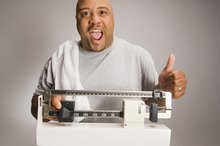What does fact checked mean?
At Healthfully, we strive to deliver objective content that is accurate and up-to-date. Our team periodically reviews articles in order to ensure content quality. The sources cited below consist of evidence from peer-reviewed journals, prominent medical organizations, academic associations, and government data.
The information contained on this site is for informational purposes only, and should not be used as a substitute for the advice of a professional health care provider. Please check with the appropriate physician regarding health questions and concerns. Although we strive to deliver accurate and up-to-date information, no guarantee to that effect is made.
What Is the Easiest Way to Gain Weight & Still Have a Six-Pack?
Weight gain can be tricky, especially when you're trying to gain to build muscle. If you're trying to maintain a healthy physique, you won't find an easy method to add weight. The key to healthy weight gain -- and keeping that six pack -- is to gain it slowly eating the right foods and working out to build. Consult your doctor or dietitian to help you determine what diet and workout plan works best to meet your diet and physique needs.
Slow-Paced Weight Gain
If you're trying to gain weight and keep your six-pack, then you want your weight gain to be muscle, which can take months to years 1. Slow weight gain means you're shooting for a 1/2-pound weekly weight gain, which will help ensure you're not gaining too much fat. Weight gain requires a shift in your caloric intake, eating more calories than your body needs. How many extra calories you need depends on your genetics and your workout. Start by adding 250 calories to your current intake and increase or decrease as needed until you're gaining at the recommended pace. Going slow may help limit fat weight gain, so you'll still have a visible six-pack.
- If you're trying to gain weight and keep your six-pack, then you want your weight gain to be muscle, which can take months to years 1.
- Slow weight gain means you're shooting for a 1/2-pound weekly weight gain, which will help ensure you're not gaining too much fat.
Six-Pack Weight Gain Diet
How Can a 260-pound person who works out every day lose fat and gain muscle?
Learn More
Food quality counts when you're trying to gain weight the right way. Ditch the processed foods, such as cupcakes and french fries, and eat a variety of whole foods to get the calories you need. Go for higher-calorie options from each of the major food groups to make every bite count. Raisin bran, quinoa and dense whole-grain breads are good grain options. Try dried fruits or avocados and starchy vegetables such as peas, corn and potatoes for nutrient-rich calorie-dense fruits and vegetables. Add cheese to sandwiches and veggies for extra calories from the dairy group, and use low-fat milk and yogurt instead of nonfat. Nuts, seeds, eggs and hummus are high in calories and a good source of protein for your weight-gain diet.
- Food quality counts when you're trying to gain weight the right way.
- Ditch the processed foods, such as cupcakes and french fries, and eat a variety of whole foods to get the calories you need.
Work Out All Muscles
You may be most concerned about keeping your rock-hard abs, but you need to work out all your muscles, not just your abs, for balanced weight gain. Commit to strength-training two to three days a week on nonconsecutive days, during which you work out all the major muscle groups, including shoulders, chest, arms, abs, legs and back, at least once during each workout. You can build muscle using free weights, a resistance band or body resistance exercises such as lunges, squats, pull-ups and sit-ups. Do four to eight repetitions of each exercise two to three times.
Eat small amounts of protein, such as hard-cooked eggs, Greek yogurt or a cup of low-fat chocolate milk, before and after your workout to help with muscle building.
- You may be most concerned about keeping your rock-hard abs, but you need to work out all your muscles, not just your abs, for balanced weight gain.
- Commit to strength-training two to three days a week on nonconsecutive days, during which you work out all the major muscle groups, including shoulders, chest, arms, abs, legs and back, at least once during each workout.
A Little Cardio
How To Lose Weight with Dumbbells
Learn More
To help stay lean while building muscle, include some cardio in your workout routine. Work out at a moderate pace two to three days a week for 20 to 30 minutes to maintain your cardiovascular fitness without burning too many calories, and take in enough extra calories on the days you work out to help compensate for the calories you burn. Add calorie boosters such as nonfat dried milk powder to your yogurt or your smoothie or a spoonful of oil to your veggies.
Related Articles
References
- Better Health Channel: Weight and Muscle Gain
- ExRx.net: Fat Loss and Weight Training Myths
- Orsama AL, Mattila E, Ermes M, Van Gils M, Wansink B, Korhonen I. Weight rhythms: weight increases during weekends and decreases during weekdays. Obes Facts. 2014;7(1):36-47. doi:10.1159/000356147
- Wilkinson DJ, Piasecki M, Atherton PJ. The age-related loss of skeletal muscle mass and function: Measurement and physiology of muscle fibre atrophy and muscle fibre loss in humans. Ageing Res Rev. 2018;47:123-132. doi:10.1016/j.arr.2018.07.005
Writer Bio
Jill Corleone is a registered dietitian and health coach who has been writing and lecturing on diet and health for more than 15 years. Her work has been featured on the Huffington Post, Diabetes Self-Management and in the book "Noninvasive Mechanical Ventilation," edited by John R. Bach, M.D. Corleone holds a Bachelor of Science in nutrition.









